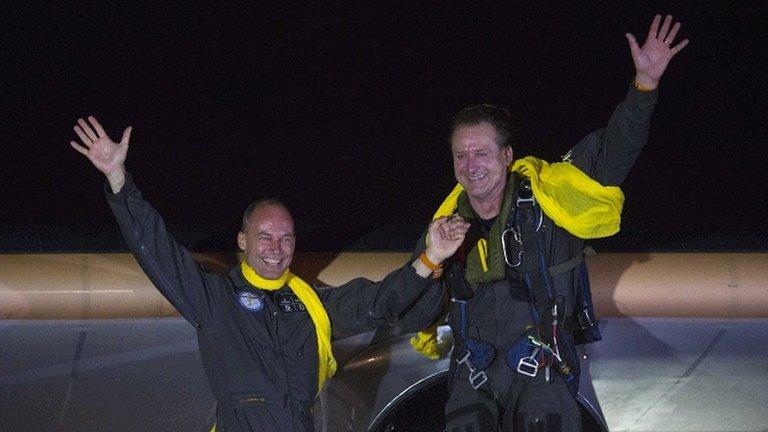Solar Impulse: Plane completes Ahmedabad to Varanasi leg
- Published

Andre Borschberg touches down in Varanasi - LEDs light up the front surface of the wings
Solar Impulse, the solar-powered plane attempting to fly around the world, has completed the first leg in a two-hop journey from India to Myanmar.
Solar Impulse, with Andre Borschberg at the controls, left Ahmedabad early on Wednesday, touching down a little over 13 hours later in darkness in Varanasi.
It will be just a short "pit stop" in India's northeast before the vehicle pushes on over the Bay of Bengal.
The leg to Mandalay in Myanmar (Burma) will be flown by Bertrand Piccard.
The two pilots are taking it in turns to guide Solar Impulse on its circumnavigation of the globe.
So far, they have covered about 3,000km in the three segments flown since beginning the adventure in Abu Dhabi on 9 March.
It will likely be another five months before they return to the United Arab Emirates, having crossed both the Pacific and Atlantic oceans in the process.
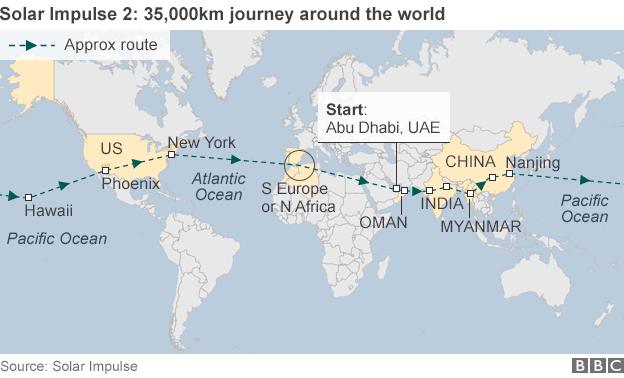
Wednesday's take-off was delayed by almost two hours because of customs issues.
But then Borschberg completed the roughly 1,100km from Ahmedabad to Varanasi slightly faster than had been anticipated.
The team is laying over for about eight hours before taking off for Mandalay.
This fourth leg is longer - about 1,500km - and has some tricky conditions to negotiate.
"In Varanasi, we can expect to have foggy mornings, which could be a problem for an early take-off," explained Christophe Beesau, who works on flight strategy.
"And for leg four, of course, we will cross the Bay of Bengal. This may be challenging because we have often at altitude an important wind, and, on the other hand, due to air traffic control restrictions, we have to keep the track.
"We know that we will have to adjust carefully the flight profile to avoid this problem."
Also, about two hours before landing in Mandalay, Solar Impulse will have to fly over a big range of mountains up to 3,000m in height.
It will aim to get this done before sunset so that it can then gently descend towards the Myanmar city in the dark.
The solar plane took off from Ahmedabad on Wednesday morning
The Solar Impulse project has already set plenty of world records, including the greatest distance covered in a single solar-powered flight.
This was the 1,468km attained on leg two from Muscat in Oman to Ahmedabad.
The wingspan of the vehicle is 72m, which exceeds that of a 747 jumbo jet airliner. It does, however, only weigh 2.3 tonnes.
Its light weight will be critical to its success over the coming months.
So, too, will the performance of the 17,000 solar cells that line the top of the wings, and the energy-dense lithium-ion batteries it will use to sustain night-time flying.
Solar Impulse
Solar-powered round-the-world bid
35,000km
total distance to travel
-
3,000km flown so far
-
1,468km Leg 2 broke World Record for single solar-powered flight
-
17,000 solar cells in wings power the plane
-
72m wingspan
The Pacific and Atlantic crossings will require Solar Impulse to fly non-stop for several days at a time.
This will put tremendous stress on Borschberg and Piccard, who will be permitted only short cat-naps on these long legs.
The Solar Impulse venture recalls other great circumnavigation feats in aviation - albeit fuelled ones.
In 1986, the Voyager aircraft became the first to fly around the world without stopping or refuelling.
Piloted by Dick Rutan and Jeana Yeager, the propeller-driven vehicle took nine days to complete its journey.
Then, in 2005, this time was beaten by the Virgin Atlantic GlobalFlyer, which was solo-piloted by Steve Fossett.
A jet-powered plane, GlobalFlyer completed its non-stop circumnavigation in just under three days.
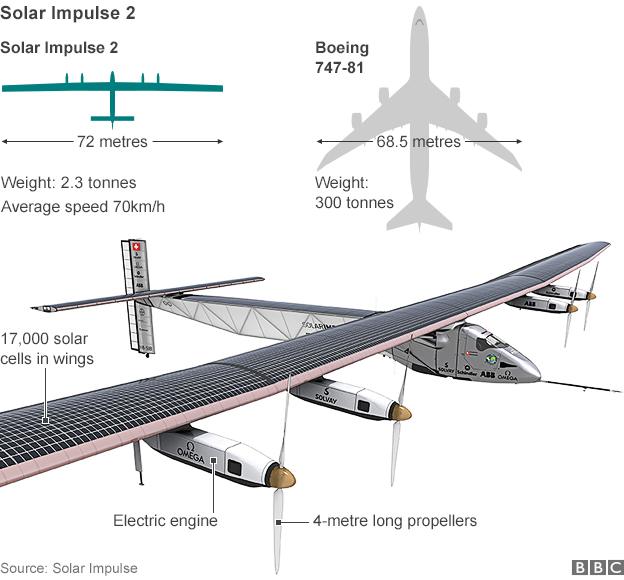
Jonathan.Amos-INTERNET@bbc.co.uk and follow me on Twitter: @BBCAmos, external
- Published10 March 2015
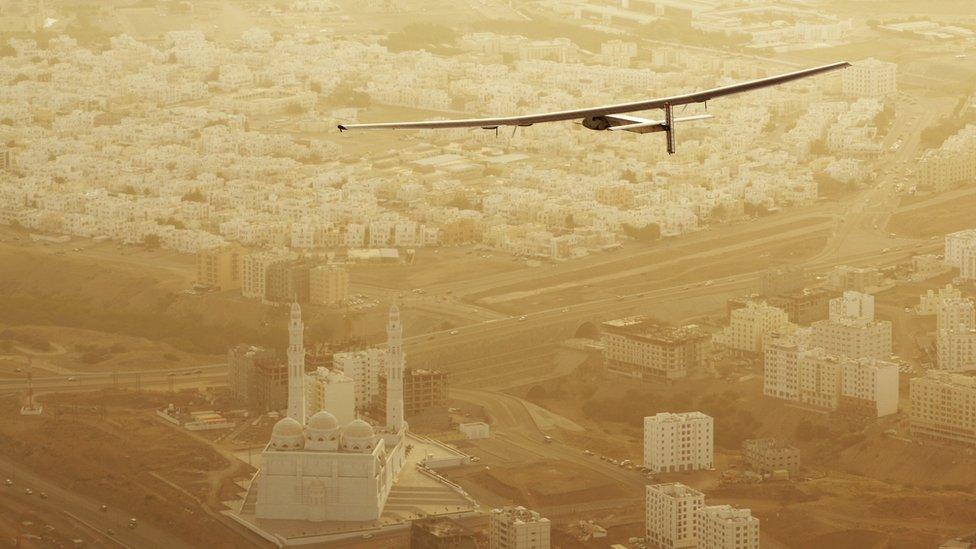
- Published9 March 2015
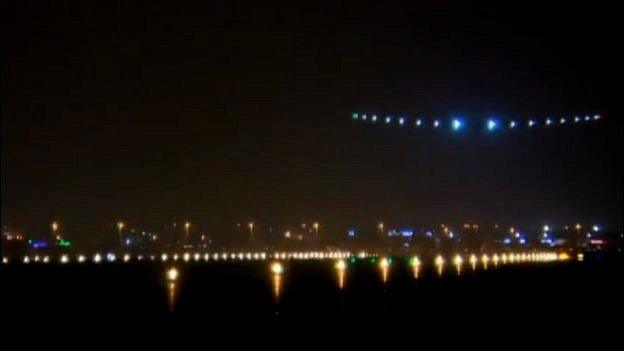
- Published2 June 2014
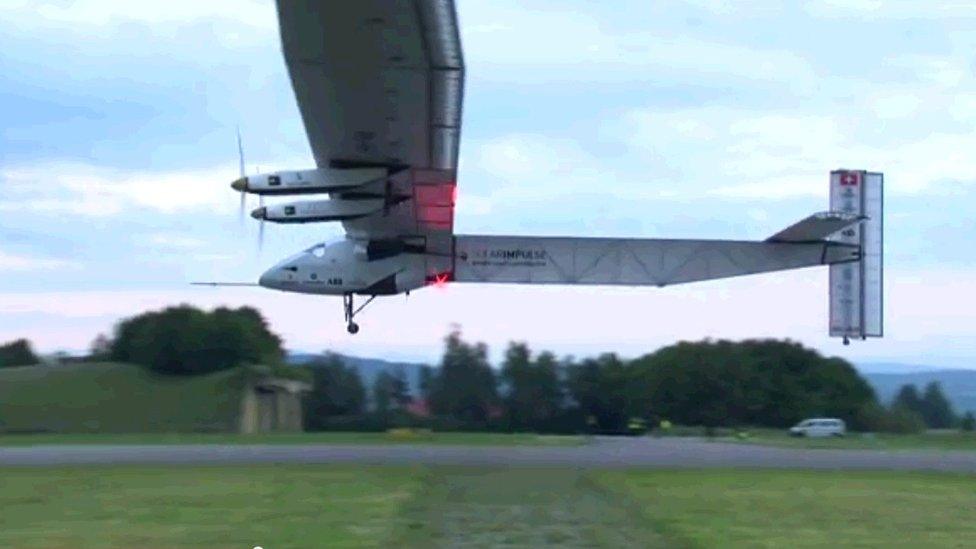
- Published7 July 2013
